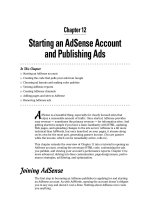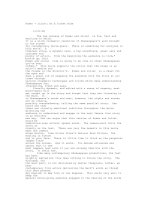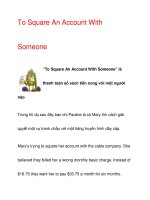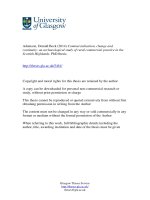Designing Your AdWords Campaign and Starting an Account
Bạn đang xem bản rút gọn của tài liệu. Xem và tải ngay bản đầy đủ của tài liệu tại đây (1.39 MB, 28 trang )
Chapter 7
Designing Your AdWords
Campaign and Starting
an Account
In This Chapter
ᮣ
Structuring an AdWords account
ᮣ
Understanding Campaigns, Ad Groups, and keywords
ᮣ
Setting marketing and budgetary goals
ᮣ
Preparing your landing page
ᮣ
Writing effective ad copy
ᮣ
Opening and activating an account
A
successful AdWords campaign demands ongoing effort, but in that effort
are opportunities for correction, refinement, and improved returns. There
is no “throwing the switch” of an AdWords campaign in the same sense as in
traditional advertising, where a media purchase is contracted and runs along a
predefined course. Instead, successful AdWords advertisers continually
experiment with new variables, remove underperforming aspects, and brain-
storm new angles. AdWords is addictive.
Remember these two points:
ߜ Starting an account does not necessarily start your campaign.
ߜ Starting your campaign does not represent the end of your work.
12_571435 ch07.qxd 5/21/04 11:32 PM Page 117
On the second point, it is vitally important to be clear from the start: A suc-
cessful AdWords campaign requires ongoing testing and experimentation. I
don’t mean a successful campaign “thrives on” testing, or “would benefit from”
testing. I mean that success requires testing. Without an initial period of testing
and experimentation, you will almost certainly fail. I won’t be so fierce later,
so hear it now: It is painfully easy to fail at AdWords. Almost all successful
CPC advertisers failed before they succeeded.
With careful planning and an understanding of campaign elements, you can
minimize the pain and expense of the inevitable period of trial and error.
Before putting ads into play, read as much of Part II as your impatience allows.
Google’s assurance that you need only five dollars and 15 minutes to get
started is literally true, but actual experience is far more complicated. You
should get involved with Google AdWords methodically and carefully.
The purpose of this chapter is to give you a better idea of how you budget,
organize, and track an AdSense campaign, write ad copy, and research key-
words. When you understand those tasks, you’ll be sufficiently well-informed
to open and activate an account. Then, with your account activated and at
least one ad in distribution, you’ll be ready to read the other three chapters
in Part II. Chapter 8 details the administrative tools. Chapter 9 explores the
maintenance and improvement of the campaign’s building blocks — Ad Groups
and keywords. Chapter 10 rounds up miscellaneous points and deals with
multiple campaigns.
Now, onwards to the nitty-gritty of the AdWords program.
The Big Picture: Campaigns,
Ad Groups, and Keywords
The AdWords sign-up process, which I describe later in this chapter, makes it
seem as though running an ad campaign were an effortless, 15-minute process.
Indeed, it can be — though launching a campaign with so little preparation is
like hang-gliding without a breeze. Even if you’ve planned your budget and
have a list of keywords, you should give some thought to the organization of
your campaign.
Google provides organizational layers to your campaign that make it possible
to test different marketing angles, track their performance, and discontinue
ineffective approaches while letting robust ads run. You must use these orga-
nizational features to some extent, and I encourage you to become as fluent
in their use as possible.
118
Part II: Creating and Managing an AdWords Campaign
12_571435 ch07.qxd 5/21/04 11:32 PM Page 118
This section helps you conceive your campaigns according to the framework
furnished by AdWords, which is shown in Figure 7-1. You can always backpedal
from a campaign that you’ve organized with insufficient attention to detail, and
reorganize it more usefully. But you can avoid that headache by planning, from
the start, in highly defined marketing modules.
An AdWords account contains three organizational levels:
ߜ Keywords. Keywords are the terms people use to search, and they trig-
ger your ads. Almost every keyword is assigned an individual cost-per-
click value.
ߜ Ad Groups. Ad Groups contain clusters of keywords, each of which is
associated with one or more ads.
ߜ Campaigns. Campaigns contain Ad Groups.
Ad Group
Campaign
Keyword
(ads automatically rotated)
Keyword
Keyword
Widgets – March sale
Free shipping over $25
All varieties, low prices
www.WidgetsNow.com
Widgets – all varieties
March clearance sale
Click for free shipping
www.WidgetsNow.com
Ad Group
Keyword
Blue widgets for spring
Free shipping over $25
March clearance sale
www.WidgetsNow.com
Figure 7-1:
Each Ad
Group in a
Campaign
contains
one or more
keywords
and one or
more ads.
119
Chapter 7: Designing Your AdWords Campaign and Starting an Account
12_571435 ch07.qxd 5/21/04 11:32 PM Page 119
You might be thinking (yes, I can see your thoughts, so please clear all
images of Carrot Top from your mind), “How peculiar that ads don’t repre-
sent an organizational level.” Ads are associated with one or many keywords.
You may associate one ad with one keyword; one ad with multiple keywords;
multiple ads with one keyword; or multiple ads with multiple keywords. Each
of these configurations can make up an Ad Group. The defining feature of an
Ad Group is the keyword(s) associated with it, not the ad(s). Strange, I know.
Let it go for now; I return to Ad Groups later.
120
Part II: Creating and Managing an AdWords Campaign
Google’s strong medicine
Google doesn’t tolerate failure among its adver-
tisers, but its standards of success might differ
from yours. Google is concerned with just one
campaign statistic: the clickthrough rate (CTR).
After an AdWords Campaign generates 1000
impressions, Google takes action on the ads
associated with underperforming keywords. The
standard of acceptable performance is, more or
less, one half of one percent (0.5%) CTR. If an ad
fails to elicit 5 clickthroughs out of every 1000
impressions, on average, Google might disable
the keyword associated with that ad, meaning
that the ad is prevented from appearing on
search pages for that keyword. (If more than one
keyword is associated with the ad, Google tracks
the CTR for each keyword individually, and pre-
vents ads from displaying on search pages for
those underperforming keywords.)
Before disabling keywords, Google puts an “At
risk” warning next to them, as shown in the
figure. The next step is to “Slow” the keywords,
which really means slowing the distribution of
ads associated with those keywords. During
this slowdown, keywords not at risk continue
performing normally, and ads associated with
those healthy keywords appear unhindered on
search results pages. But Google’s medicinal
pill is bitter because all instances of a slowed
keyword across all Ad Groups are slowed, even
if in some of those instances the ads associated
with those keywords are performing ade-
quately. You must correct the problem by elimi-
nating keywords from the Ad Groups in which
they are executing badly.
Google’s focus on clickthrough rate is an exam-
ple of the company’s obsessive concern for the
quality of the Google search experience. If ads
don’t attract clicks when displayed on certain
results pages, in Google’s eye it means that
those ads are not relevant to the page and don’t
deserve to be on it. You perhaps don’t care as
much about CTR and almost certainly care more
about your conversion rate on the clicks you do
get. But you must keep your CTR up to Google’s
standard to avoid slowing the entire campaign.
When it comes to underperforming, slowed, and
disabled keywords, remember that even though
Google targets the keyword as the faulty ele-
ment of the campaign, the problem could lie
with the ad copy. True, the usual culprit in poor
CTR performance is lack of relevance between
the keyword and the ad, and the best way to
improve performance is to choose keywords
that are more relevant. But ineffective ad copy
can also discourage clickthroughs, and it’s
12_571435 ch07.qxd 5/21/04 11:32 PM Page 120
Planning the first level: Campaigns
Throughout this book, I speak so much about “the AdWords campaign” that
you might think your AdWords account is necessarily dedicated to a single
campaign. Not so. Here, I must distinguish between the generic campaign,
which is your overall marketing initiative as it applies to advertising on Google,
and the AdWords Campaign, which is a distinct organizational tier.
An AdWords account may contain multiple campaigns (see Figure 7-2).
Although I strongly recommend making organizational divisions within a cam-
paign (as I describe in the following section), running multiple campaigns is
not essential in many cases.
121
Chapter 7: Designing Your AdWords Campaign and Starting an Account
worth trying a correction there before deleting
the keyword. However, after Google brands a
keyword “Disabled,” that’s the end: You must
pluck the word out of the Ad Group.
12_571435 ch07.qxd 5/21/04 11:32 PM Page 121
Two major considerations lead advertisers to set up a second (and third)
campaign:
ߜ The advertiser is marketing different products, represented by ads, key-
word groups, and landing pages that have nothing to do with each other.
Even in this dispersed circumstance, you can accomplish the boundaries
you need by working with Ad Groups within your campaign. But establish-
ing a new campaign structure makes the Control Center pages neater and
enables simpler naming of Ad Groups. Think of campaigns as marketing
books, and Ad Groups as chapters in those books. Whether you want one
book or several depends on the diversity of your marketing initiatives.
ߜ The advertiser wants to launch ads with campaign settings that differ
from an existing campaign. Google provides seven settings that affect all
ads in a campaign. Campaign settings can be convenient and inconve-
nient. On one hand, global settings are cumbersome because you can’t
exempt specific ads from their effect. On the other hand, the ability to
set variables across the entire campaign is a valuable shortcut.
Knowing how to organize your marketing effort into AdWords campaigns
requires a clear understanding of the Campaign settings. Google divides the
Edit Campaign Setting page (see Figure 7-3) into several sections.
Figure 7-2:
An AdWords
account
running
three
campaigns,
each with
multiple Ad
Groups.
Some Ad
Groups are
paused.
122
Part II: Creating and Managing an AdWords Campaign
12_571435 ch07.qxd 5/21/04 11:32 PM Page 122
Here are the settings of each campaign that you need to consider when orga-
nizing your entire AdWords structure:
ߜ Name. From an organizational viewpoint, the campaign name is proba-
bly the least important setting. Of course, you want to name your cam-
paigns distinctly. If the name is the only difference among your planned
campaigns, you might as well lump them together and distinguish them
in Ad Groups.
ߜ Daily budget. This setting is where you choose your spending cap per
day. (Later sections of this chapter cover AdWords budgeting in detail.)
This important setting, by itself, could determine a dedicated campaign
in your AdWords account, even if it advertises a product similar to one
in a campaign with a higher or lower daily budget.
Suppose that you sell kayaks and kayak supplies. Normally, you would
probably consider your entire business to be under one campaign roof.
But if you market a landing page filled with inexpensive accessories (water
boots, paddling gloves, roof racks) separately from a landing page dedi-
cated to the relatively expensive boats, you might decide to budget more
money per day to a campaign driving traffic to the latter page. Such a
Figure 7-3:
Campaign
settings
apply
globally
to all Ad
Groups
in the
Campaign.
123
Chapter 7: Designing Your AdWords Campaign and Starting an Account
12_571435 ch07.qxd 5/21/04 11:32 PM Page 123
decision would be based on a host of considerations such as relative
profit margins, clickthrough rates, and your maximum CPC. Tinkering with
this setting on a campaign-wide level is possible only if you make intelli-
gent and thoughtful divisions of your marketing strategy in advance.
Adamant though I am that you plan your account organization, remem-
ber that the whole shebang is reconfigurable. You may rearrange your
campaigns and Ad Groups anytime. Doing so is not exactly a drag-and-
drop process, though, so planning is advisable.
ߜ Campaign schedule. Here, you determine start and end dates for the cam-
paign. Because all campaigns (and Ad Groups within campaigns) may be
paused and resumed at will, this variable usually isn’t changed from its
default end date, which is December 31, 2010 — effectively an indefinite
campaign run. However, setting an end date is useful when you can’t mon-
itor the campaign closely.
ߜ Optimization. Google optimizes the rotation of the various ads within
your campaign — at the Campaign level, not the Ad Group level. Opti-
mization involves determining which ads in the campaign enjoy higher
clickthrough rates than other ads and skewing the distribution of your
ads toward those that perform better. You may turn off this feature at
the Campaign level, but not at the Ad Group level (where it would proba-
bly be more productive).
ߜ Content site distribution. You may also distribute your ads across the
Google content partner network. This network consists of content sites
that have agreed to enable AdWords ads to appear on relevant pages.
This network does not include search sites that Google licenses to, such
as AOL Search and Netscape. Your campaign can be distributed through-
out the content network of non-Google sites at your discretion.
ߜ Languages. All advertising is language specific, determined by the lan-
guage in which the ads are written. Google can isolate the language used
by individuals based on their Preferences setting. When you set a lan-
guage choice at the Campaign level, all your ads should be written in
that language, and they are all directed at Google users in that language.
ߜ Countries. Related to the language setting, this variable allows you to
target users by their geographical location. Google locates its users based
on their IP address, which works in most (but not all) cases. Currently,
you may target your campaign to any combination of dozens of coun-
tries or fine-tune your targeting to a U.S. region or a combination of U.S.
regions.
Note: Chapter 10 contains more detail about language targeting and geo-
targeting.
124
Part II: Creating and Managing an AdWords Campaign
12_571435 ch07.qxd 5/21/04 11:32 PM Page 124
Those new to AdWords have no way to evaluate the relative importance of
campaign settings or to forecast the optimal division of their marketing. So,
with the voice of experience, let me recommend that you pay close attention
to three campaign features in particular: the daily budget, language targeting,
and location targeting. Those three settings are the most important and are
the variables most worthy of earning a campaign dedicated to them. Being
able to adjust these settings across a suite of Ad Groups is vitally convenient.
The targeting they represent is so crucial in some marketing plans that defin-
ing campaigns by these settings might be more important than dividing the
account by product line. Ideally, though, major organizational criteria coin-
cide, so that product type, budgetary requirements, language targeting, and
geo-targeting all suggest the same campaign divisions.
Planning the second level: Ad Groups
Ad Groups are the gears that propel your campaign. They’re the most impor-
tant unit of most organizational plans. Every account contains at least one cam-
paign, and every campaign contains at least one Ad Group. (See Figure 7-4.) For
this reason, Ad Groups are unavoidable, yet they are easy to disregard. The 15-
minute plan hyped by Google establishes a simple Ad Group in a solitary cam-
paign. Advertisers who let their marketing rest with that simple scheme never
get their hands on the real power of AdWords: the power of highly specific tar-
geting and CPC budgeting.
Ad Groups are somewhat misnamed — they’re not necessarily groups of ads.
Ad Groups are not necessarily groups of keywords, either, but they’re more
likely to contain clusters of keywords than clusters of ads. I touched on this
peculiar subject earlier in the chapter. Here, I reiterate the four possible com-
binations that might make up an Ad Group:
ߜ One ad associated with one keyword
ߜ One ad associated with multiple keywords
ߜ Multiple ads associated with one keyword
ߜ Multiple ads associated with multiple keywords
The last of these is perhaps the most common, but good reasons exist to
create Ad Groups with a single keyword, or a single ad, or both. In fact,
Google encourages precision and diversity. The more detailed you get, the
more maintenance is required, with the reward being greater precision in
tracking results in the account.
125
Chapter 7: Designing Your AdWords Campaign and Starting an Account
12_571435 ch07.qxd 5/21/04 11:32 PM Page 125
Ad Groups are defined by keywords more than by ads in two ways. First, as I
noted, an Ad Group is more likely to contain a group of keywords than a group
of ads. (See Figure 7-5.) Second, and more importantly when conceiving of Ad
Groups, the better strategy is to build Ad Groups around targeted keywords
than around ad copy.
As with all other aspects of Google marketing (repeated to the point of tedium
in this book), Google is all about keywords no matter how you approach it. Ad
Groups should be conceptually founded on keywords, not ad text. You might
want to think of Ad Groups as keyword groups.
Ad Groups are bundles of marketing energy that connect four essential con-
stituents of your campaign:
ߜ Keywords
ߜ Ads
ߜ CPC bids
ߜ The landing page
Figure 7-4:
This
AdWords
Campaign
contains
three Ad
Groups, one
of which is
paused.
126
Part II: Creating and Managing an AdWords Campaign
12_571435 ch07.qxd 5/21/04 11:32 PM Page 126
In formulating an Ad Group, you first identify your marketing goal — even
before choosing keywords or writing ads. Then you identify your target cus-
tomers by the keywords they will most likely search for. These keywords form
the core of your Ad Group. Researching these words and phrases requires
ingenuity, persistence, testing, and familiarity with interactive tools.
After you’ve determined a preliminary set of keywords, you create one or
more ads. (Google has you create the ad first and then load up the keywords,
as I describe in the next chapter. But Google’s procedural order doesn’t
match smart conceptual order. Base your Ad Group, and your entire market-
ing thrust, on keywords.) With your keywords and ads in place, you set a
maximum cost-per-click for the entire Ad Group and individual CPCs for sep-
arate keywords if you want. Your landing must be ready by the time you
launch the Ad Group, but besides that obvious requirement, it doesn’t
matter when you construct it.
Figure 7-5:
This man-
agement
page shows
the inside
of an Ad
Group,
containing
three
keywords
and one ad.
127
Chapter 7: Designing Your AdWords Campaign and Starting an Account
12_571435 ch07.qxd 5/21/04 11:32 PM Page 127









